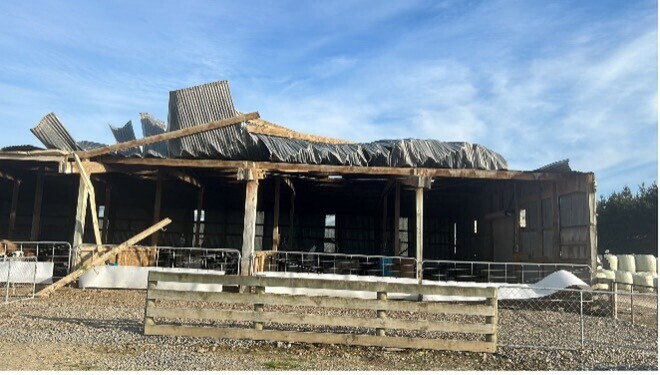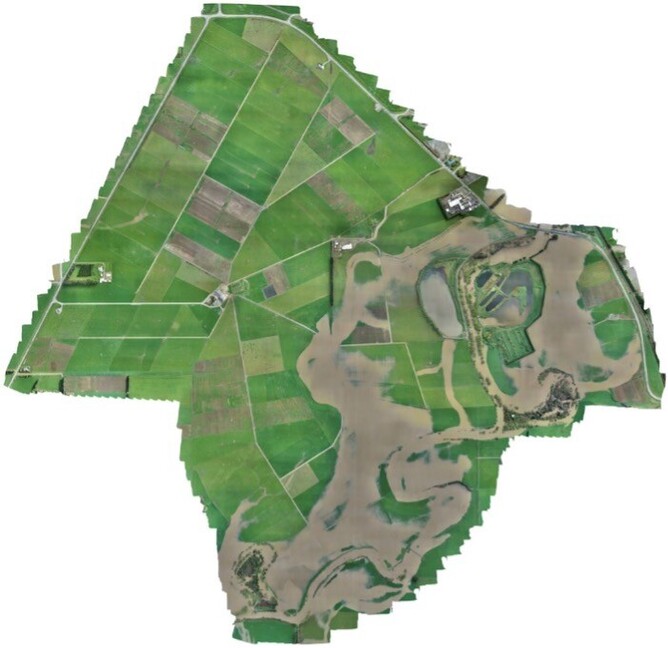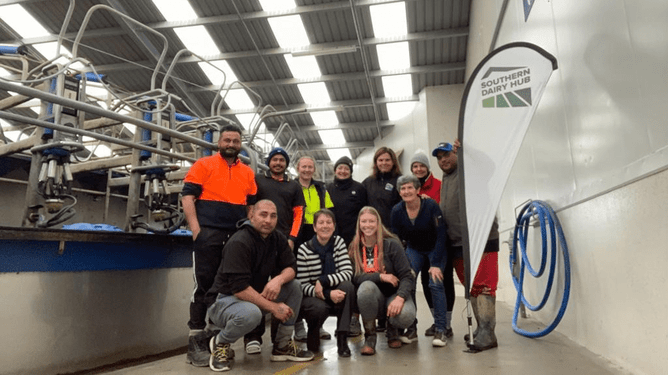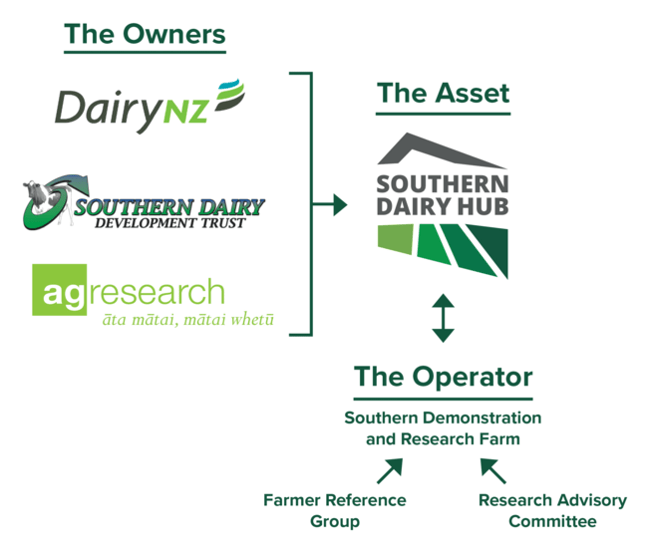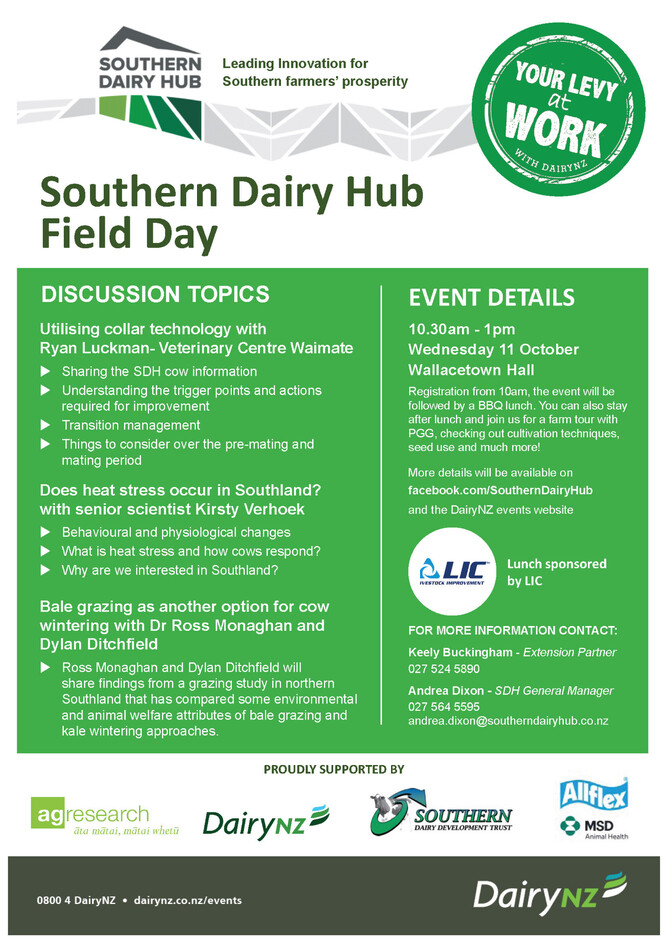Welcome to our inaugural
Southern Dairy Hub newsletter
Firstly, hello! I recently started as the new General Manager at the SDH in July and it’s been a big few months of learning about the Hub and the amazing research work on the working and fully operational farm.
Flooding and winds
The last couple of weeks have been dominated by managing the fallout from the wet and windy weather. Like much of the southern end of the South Island we took the brunt of firstly, gale force winds that took the top off our shed, and then followed by heavy rainfall that flooded our farm and compounded the damage caused by the winds. This was the biggest flood the SDH has experienced since the farm was converted.
The team have been assessing the damage, now that most of the water has receded. We have one laneway requiring some repairs and debris to clear off fences. On the front of the calfshed the tin has been removed from the damaged section and it will be a couple of weeks before a new roof can be fitted.
Check out this drone footage a few hours before the flood peaked, thanks to Tim Campbell from Campbell Water Design Ltd. This image together with the ES flow data and river levels will allow us to plan better for future events.
Farm budgets
Meanwhile, I’ve also been managing the farm budgets alongside the complexity of delivering research. I’ve truly appreciated how the Hub couldn’t function without the support of the owners, the funders and the supporters. To the many funders and supporters, often small local businesses and local farmers, who provided funding support, in-kind support and much more – thank you.
How farmers want to hear from the Hub
AgResearch recently carried out a farmer survey about SDH to help us understand what farmers want to hear about and how they want to hear from us. This is what we learnt. Farmers want to hear about wintering, pre and post calving management, soils, crop research, GHGs, environment, HR, the DairyNZ infrastructure project at the Hub and understanding on-farm challenges. You wanted to get updates on these things through email, our website, and Facebook – and through Field Days and events.
Sharing what’s happening with you
It’s a priority for me to share more with you about what’s happening at the farm. Our whole aim is to support research that is targeted and useful for southern farmers and that is useful on-farm.
Therefore, you’ll see seasonal e-newsletters come out from us – we’re very excited to get this first one out and value any feedback you might have. I’ll also have a quick chat every month on The Muster radio programme. Check out our refreshed website, Facebook page and sign up to our Weekly Research Notes.
And finally, join us at our Field Day on 11 October.
About the Farm
332 eff ha, 300 dairy, 32 support, 750 Fr-crossbred cows, cowshed: automated 60-bail DeLaval Rotary, our effluent is weeping walls, 90-day pond, low application rate irrigators.
Located close to Invercargill, the Southern Dairy Hub (SDH) was established in 2017 as a research farm. It is the largest farm of its type in New Zealand and one of the bigger ones internationally - something the whole region can be proud of.
The Southern Dairy Hub’s 349-hectare facility is jointly invested in by southern dairy farmers, AgResearch and DairyNZ.
It operates as a working dairy farm as well as a site for important research that gives farmers great data to help them make decisions about their environmental footprint, profitability and looking after their animals. It’s targeted at the very specific regional challenges local farmers face because of soil types and weather conditions.
It’s thanks to the generosity of the community, sponsors, and funders that it’s able to deliver the groundbreaking research that it does.
With four farmlet systems of about 200 cows each to allow direct comparisons, the Hub and its research team trial the performance of different crops, feeding approaches and systems, focusing on the impacts on productivity and profitability.
Meet the team
At SDH we have a full time operational team and then a research team of two DairyNZ technicians.
We’ve got a complex set up that differentiates the owners, the asset (the farm) and the farm operators.
From the farm: The Importance of managing BCS from Calving to Mating
At the Southern Dairy Hub our trained DairyNZ team carry out a Body Condition Score (BCS) on every cow once a fortnight throughout the season. We also utilise our DeLaval DelPro BCS Camera throughout the season and record daily scores that are then uploaded into MINDA. We use this data in our weekly meetings to make proactive decisions based on each animal’s condition – are they dropping in condition or not compared to where we would want them to be for the time of the season? Looking after our cows and making sure their welfare is a priority is crucial.
The data is detailed and really useful. For the 2022 season, our cows were at BCS 5 and our heifers 5.5 at calving (July 2022). We were proactive in our decisions to make changes to any animal that had a low BCS (below the industry targets of 5 BCS for cows and 5.5 BCS for two- and three-year-olds) at calving and aiming to not let this drop more than 1 BCS leading into mating.
At calving, the mixed-aged cows remain in the colostrum mob for four days and the heifers for five days. All cows are milked OAD for the first 14 days of lactation. If there are any concerns with individual cows, especially if they’ve had issues at calving, they remain on OAD until their condition improves. Animals are also priority fed to help lift condition.
From the tables below we can see the benefits of monitoring BCS from calving to mating. The animals that only dropped 0.5 of a score had far superior in-calf results than those that dropped more than 0.5 of a BCS score. The highlight is the performance of the two- and three-year-olds that had six week in-calf rates of 86% which is much higher than the Southland average of 71% for two- year olds and 69% for three-year olds. The same year group that dropped more than 0.5 BCS had a six week in calf rate of 76%.
The “not in-calf” rates are also considerably lower for the animals that lost less than 0.5 BCS between calving and mating in particular the two- and three-year-olds.
Managing BCS can be a real balancing act as we try to reduce BCS loss while also trying to maximise peak production. We can see from our results last year, that focusing on BCS from calving to mating has lifted our in-calf rates for these animals, which in turn will lift our production in the subsequent season as they will be calving earlier and remain in the herd for longer.
The “crux” of “missing out” on some of this year’s production to improve cow lifetime production and calving earlier will mean better lifetime production. Given the number of herd tests we undertook last year we can calculate an estimated cost of focussing BCS v. production.
We estimate this cost to be 20 kgMS per cow for the season (mainly from the move to OAD). However, with an 8% lift in six-week in-calf rate and a 7% lower not in-calf rate in cows that lose less BCS, this comes close to recovering some of that “loss”.
This doesn’t consider the positive production benefits over the lifetime of the cow. If we moved 479 cows (this is how many were in this group last year) that lost more than 1 BCS to losing only half a BCS this would be equivalent to 9,580 kgMS less production @ $6.75 totalling $65,000.
However, the improved repro benefits are 8% better for the six-week in-calf rate x $4 x 479 = $15,328. The improved not in-calf rate is 7% lower NICR x $10 x 479 = $33,530 for the season and not factoring in seasonal cumulative benefits.
Review of SDH Farm Systems trial 2018-2021
Dawn Dalley, DairyNZ Senior Scientist, provides a summary of the SDH Farm Systems Trial from 2018-2021.
Research priorities for the southern regions of the South Island, identified by farmers in 2017 included wintering, fodder beet, achieving nutrient loss reduction targets and integration of off paddock infrastructure into southern systems. These results highlight a tension between environmental benefits and profitability.
A DairyNZ farm systems comparison trial was set up at SDH to identify systems with reduced environmental footprint and better understand the challenges with wintering on fodder beet and offering it as a lactation supplement. At the time the project was set up fodder beet feeding was at its peak and farmers were concerned about potential negative effects on production and reproduction.
The resulting farm systems studied the use of kale and fodder beet as winter crops at two levels of system intensity. The lower intensity systems were designed based on modelling to achieve a 30% reduction in nitrate leaching. Key mitigations for these farmlets were applying less N fertiliser (180 versus 50 kg N/ha/annum) and lactation supplement type (barley/PKE blend versus fodder beet). With less total feed in the lower intensity systems the stocking rate was reduced from 3.1 to 2.6 cows/ha.
This project has confirmed some of the negative impacts of feeding fodder beet but has also highlighted some opportunities to improve winter BCS management and reduce environmental footprint.
Cows wintered on kale produced 4-5% more milksolids and had fewer animal health issues and less reproductive intervention. This resulted in better system profitability - however cows wintered on fodder beet had better BCS gain and achieved more days in milk. Fodder beet systems reduced nitrate leaching by 12-20% and methane emissions by 9%. Reducing nitrogen fertiliser use increased clover in pastures from 8% to 17% - but reduced annual growth by 1.5 tonnes of DM/ha, an overall N response rate of 12:1.
Future fodder beet systems need to maximise the environmental and BCS benefits while maintaining production and profitability. We believe this is possible but will require a reset of feeding levels and length of feeding. This will be addressed in the new farm systems comparison.
Farmers to get answers on soil sequestration
Mike Dodd, AgResearch Senior Scientist is leading the research funded by MBIE’s Strategic Science Investment Fund.
Mike explains: “We can and have over the years found out about carbon concentration levels in farmed soils, but we don’t have great data on amounts of carbon mass. The difference is significant. A farm could have high concentrations of carbon if, for example, the soils have been compacted. This wouldn’t necessarily translate to a farm having high levels of carbon stored in its soils though, so this research is important and timely because farmers are hoping to have carbon storage recognised in future policy setting.”
Mike says Southern Dairy Hub is the ideal place to conduct the research. The farm is divided into four units that are operated using different winter management techniques. “So the research will provide us with data on how much carbon is stored across a variety of soils and farming practices from winter cropped to permanent pasture.”
AgResearch scientists based at Ruakura (Hamilton) developed a hydraulic soil coring machine several years ago that sits on the side of a 4x4. It has been driven across 44 paddocks at the Hub taking samples down to 600 millimetres. They have been analysed for total carbon and nitrogen and at the AgResearch Ruakura lab that uses “relatively new hot water testing techniques that extract carbon and nitrogen,” says Mike. “That will give us the total carbon, and what you might call the, ‘working carbon’; the carbon that is moving in and out of the system on a short-term basis compared to the mass that's the more permanent sink”.
Mike, who sits on the SDH research advisory committee, explains: “Carbon research, traditionally has focused on soil organic matter, which we know contributes to soil health. We know more organic matter is better for soils because it contains more ability to supply nutrients, and reduces the effects of compaction. There's been a ton of research done historically on this, but of course with the new interest in mitigating climate change, soil carbon pools are a potential way of doing this.
“If you can increase what we call the sequestration of carbon from the atmosphere through the plant and into soil, then you're essentially reversing those processes associated with global climate change. There’s a lot of interest in how our pastoral management in particular can enhance that process and the tools we need to build carbon stocks. There's also quite a bit of scepticism around it. Some of the arguments sit around the fact that if you look globally permanent pastures tend to have the highest carbon stocks of any system. Then below that you've got forest soils and cropped soils. So there's some legitimate questions around if we are high already, can we get any higher? And, at the same time, you can turn that around and say, ‘well, what is the risk if we lose carbon from permanent pastures”.
“So that's an important thing to know in a New Zealand context. We have a lot of volcanic derived soils with particular properties and minerals particularly good at holding on to soil organic matter. If you look globally, our soils have potential to hold more carbon compared with Australia or the US.”
The results will be shared via the Southern Dairy Hub website: www.southerndairyhub.co.nz
Upcoming events
We look forward to connecting with you more in the future. Please pass this newsletter on to anyone you think might find it useful.
From Andrea and the SDH team


